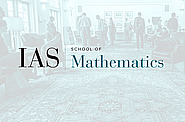2009-2010 Seminars
May
25
2010
May
24
2010
Computer Science/Discrete Mathematics Seminar I
Subsampling Mathematical Relaxations and Average-case Complexity
11:15am|S-101
May
18
2010
Computer Science/Discrete Mathematics Seminar II
Reductions Between Expansion Problems
10:30am|West Bldg. Lecture Hall
May
11
2010
May
04
2010
Computer Science/Discrete Mathematics Seminar II
Explicit Construction of RIP Matrices, Matrices With Small Coherence, and Related Problems
10:30am|S-101
Apr
27
2010
Computer Science/Discrete Mathematics Seminar II
Hardness of Approximately Solving Linear Equations Over Reals
10:30am|S-101
Apr
20
2010
Apr
19
2010
Computer Science/Discrete Mathematics Seminar I
Can Complexity Theory Ratify the Invisible Hand of the Market?
Vijay Vazirani
11:15am|S-101
Apr
13
2010
Computer Science/Discrete Mathematics Seminar II
Critical Slowdown for the Ising Model on the Two-Dimensional Lattice
Eyal Lubetzky
10:30am|S-101
Apr
12
2010
Computer Science/Discrete Mathematics Seminar I
Cover Times, Blanket Times, and Majorizing Measures
11:15am|S-101
